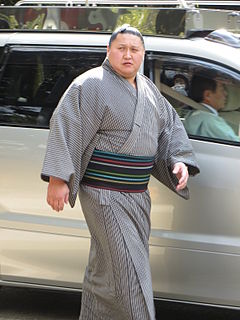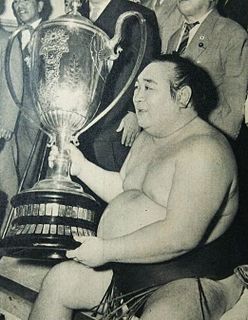
Kyokutenhō Masaru in Nalaikh, Ulan Bator, Mongolia is a former professional sumo wrestler. He made his debut in March 1992 out of Ōshima stable, with the first group of Mongolians ever to join the sport in Japan, reaching the top makuuchi division in January 1998. In his exceptionally long career he received seven special prizes for Fighting Spirit, and won one yūshō, in May 2012 from the maegashira ranks, which made him at 37 the oldest first–time yūshō winner in sumo history, and he was runner-up in one other tournament. His highest rank was sekiwake, which he held on three occasions. He was the first wrestler since the 1950s to be ranked in the top division after the age of 40. He made more appearances in the top division than any other wrestler at 1470, and only Ōshio fought more than his 1870 career bouts. He announced his retirement in July 2015 and declared his intention to stay in sumo as an elder, having acquired Japanese citizenship in 2005. In 2017 he became the head coach of Tomozuna stable and he is known as Tomozuna-oyakata.

Kaiketsu Masateru was a Japanese sumo wrestler, who reached the second highest rank of ōzeki on two separate occasions. He also won two top division tournament championships. After his retirement in 1979 he became a coach under the name of Hanaregoma-oyakata and established Hanaregoma stable. He was also chairman of the Japan Sumo Association from 2010 to 2012.

Kagamisato Kiyoji was a sumo wrestler from Aomori Prefecture, Japan. He was the sport's 42nd yokozuna.

Wakamisugi Akiteru, also known as Daigō Hisateru, was a sumo wrestler from Kagawa, Japan. The highest rank he achieved was sekiwake. He was the brother in law of yokozuna Wakanohana Kanji I.
Hasegawa Katsutoshi is a former sumo wrestler from Kurisawa, Hokkaido, Japan. He began his professional career in 1960, reaching the top division in 1965. He won eight special prizes for his achievements in tournaments and earned nine gold stars for defeating yokozuna. He won a tournament championship or yūshō in 1972 and was a runner-up in two other tournaments. His highest rank was sekiwake. He retired in 1976 and became an elder of the Japan Sumo Association, working as a coach at Sadogatake stable until his retirement in 2009.
Asahikuni Masuo (旭國斗雄), born April 25, 1947 as Takeo Ōta (太田武雄) is a former sumo wrestler from Hokkaidō, Japan. His highest rank was ōzeki. After his retirement he set up Ōshima stable which he ran from 1980 until he left the Japan Sumo Association in 2012 upon reaching the age of 65.
Maenoyama Tarō is a former sumo wrestler from Osaka Prefecture, Japan. He began his career in 1961, reaching the top makuuchi division in 1966. His highest rank was ōzeki which he held from 1970 until 1972. He retired in 1974 and became head coach of the Takadagawa stable. He left the Sumo Association in 2010 upon turning 65.
Washūyama Yoshikazu is a former sumo wrestler from Kurashiki, Okayama, Japan. He joined sumo in 1967 and reached the top makuuchi division in 1973. His highest rank was sekiwake. After his retirement in 1985 he became an elder of the Japan Sumo Association and was the head coach of Dewanoumi stable from 1996 until 2014.
Kirinji Kazuharu is a former sumo wrestler from Kashiwa, Chiba Prefecture, Japan. He made his professional debut in 1967, reaching the top makuuchi division in 1974. His highest rank was sekiwake. During his long career he won several awards and set a number of longevity records. Upon his retirement in 1988 he became a sumo coach and elder of the Japan Sumo Association, until reaching 65 years of age in 2018.
Fujinokawa Takeo is a former sumo wrestler from Otofuke, Hokkaido, Japan. He made his professional debut in May 1961 and reached a highest rank of sekiwake in May 1967. He was a runner-up in two top division (makuuchi) tournaments, finishing three wins behind Tamanoshima in May 1968 and losing a playoff to ozeki Kiyokuni in July 1969. He earned four kinboshi for defeating yokozuna and won seven special prizes. After his retirement in 1972 at the age of 26 he became an elder of the Japan Sumo Association and took over as head coach of Isenoumi stable in 1982. He left the Sumo Association in 2011 upon reaching 65 years of age.
Kaiki Nobuhide is a former sumo wrestler from Tenmabayashi, Aomori, Japan. He made his professional debut in 1965, and was promoted to the top makuuchi division in 1975. He earned three gold stars for defeating yokozuna and one special prize. His highest rank was sekiwake, which he reached in July 1979. He retired in 1987 and was the head coach of the Tomozuna stable from 1989 until 2017, training ōzeki Kaiō among others. He was also a Director of the Japan Sumo Association. In 2017 he was re-hired by the Sumo Association as a consultant after retiring as head coach.
Ōuchiyama Heikichi was a sumo wrestler from Hitachinaka, Ibaraki, Japan. He made his professional debut in 1944, and reached the top makuuchi division in 1949. He reached the second highest rank of ōzeki in 1955, and was a runner-up in two tournaments. He was well known for his extraordinary size – at 2.02 m tall he was the tallest modern era ōzeki until Akebono in 1992. After his retirement in 1959 he worked as a coach at Tokitsukaze stable and Tatsutagawa stable until his death in 1985.
Kurohimeyama Hideo is a former sumo wrestler from Ōmi, Niigata, Japan. He made his professional debut in March 1964, and first reached the top division in July 1969. After he was re-promoted to the top division in November 1969 he fought there for 71 consecutive tournaments and 1065 matches, never missing a single bout. His highest rank was sekiwake. He retired in January 1982 and became an elder in the Japan Sumo Association. He worked as a coach at Tatsunami stable, and his two sons were both wrestlers there under the shikona of Haguronada and Hagurokuni. He borrowed the Nishikijima, Yamahibiki, Dekiyama and Kitajin elder names before permanently acquiring the Takekuma name in 1988 upon the mandatory retirement of ex-sekiwake Kitanonada. Following the retirement of Tatsunami's stablemaster in 1999 he branched out to open up his own Takekuma stable, although it folded after only five years in 2004 after his only remaining wrestler (Hagurokuni) retired, and he moved to Tomozuna stable. He reached the Sumo Association's mandatory retirement age of 65 in November 2013.
Masudayama Yasuhito is a former sumo wrestler from Nanao, Ishikawa, Japan. He made his professional debut in March 1974, and reached the top division in November 1976. His highest rank was sekiwake. He retired in July 1989 and became an elder in the Japan Sumo Association under the name Chiganoura. He was the oldest man in any of the professional sumo divisions at the time of his retirement. He set up Chiganoura stable in 2004 at the age of 53, after he was passed over for the head coach position at Kasugano stable the previous year. He retired upon reaching 65 years of age in April 2016, but was re-employed by his stable as a consultant.
Dewanohana Yoshitaka is a former sumo wrestler from Nakasato, Aomori, Japan. He made his professional debut in July 1974, and reached the top division in November 1977. His highest rank was sekiwake. He retired in January 1988 and became an elder in the Japan Sumo Association under the name Dekiyama. Upon reaching the mandatory retirement age of 65 in May 2016 he was re-hired by the Sumo Association for five years as a consultant.
Shikishima Katsumori is a former sumo wrestler from Funabashi, Chiba, Japan. He made his professional debut in January 1989, and reached the top division in November 1994. His highest rank was maegashira 1. He defeated Takanohana twice in 1998 to earn his only two kinboshi for a yokozuna upset. His stablemaster, former sekiwake Aonosato retired in November 2000 and he moved from Tatsutagawa stable to Michinoku stable. He retired in May 2001 after being diagnosed with a heart ailment, and has remained in sumo as an elder of the Japan Sumo Association and coach at Michinoku. He has borrowed a succession of elder names since his retirement. Since 2013 he has been known as Urakaze.

Wakachichibu Komei was a sumo wrestler from Chichibu, Saitama, Japan. He made his professional debut in May 1954 and reached the top division in September 1958. His highest rank was sekiwake. Upon retirement from active competition he became an elder in the Japan Sumo Association, under the name Tokiwayama. He reached the Sumo Association's mandatory retirement age in March 2004.
Kairyūyama Teruhisa was a sumo wrestler from Shōwa, Akita, Japan. He made his professional debut in March 1956 and reached the top division in July 1960. His highest rank was sekiwake. He won eight gold stars against grand champion yokozuna in the course of his career. Upon retirement from active competition he became an elder in the Japan Sumo Association under the name Kiriyama. He left the Sumo Association in December 1980.
Kainoyama Isamu was a sumo wrestler from Ryūgasaki, Ibaraki, Japan. He made his professional debut in May 1955, and reached the top division in January 1961. His highest rank was sekiwake. Upon retirement from active competition he became an elder in the Japan Sumo Association under the name Onogawa. He left the Sumo Association in September 1971.
Tatsutagawa stable was a heya of sumo wrestlers, part of the Tokitsukaze ichimon or group of stables. It was active from 1971 until 2000.








